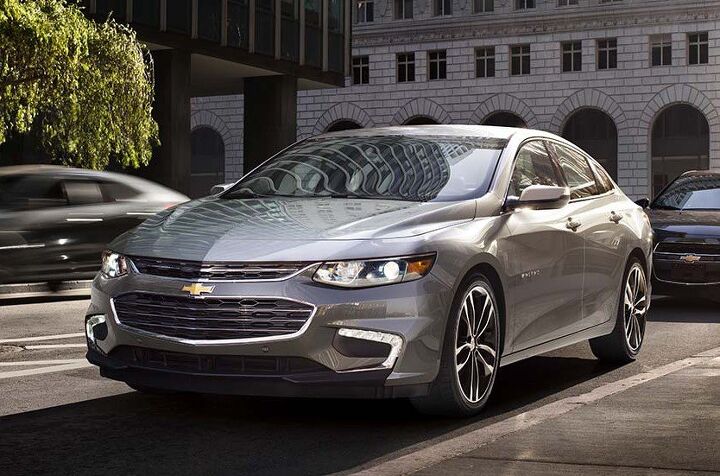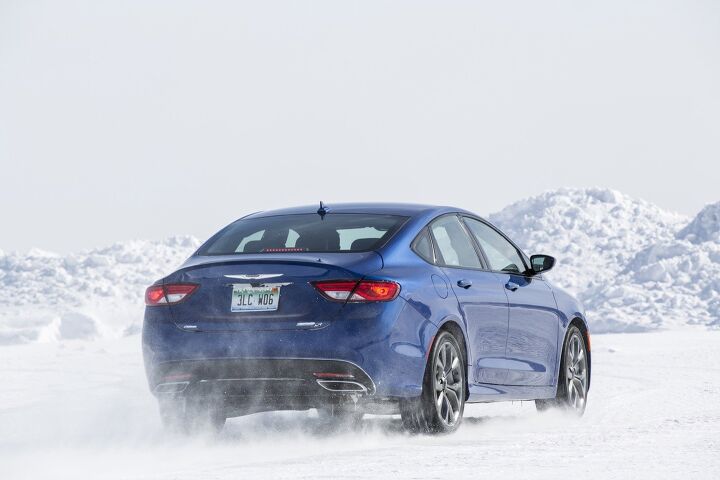#MidsizeCars
Midsize Sedan Deathwatch #10: In April 2017, Cannibal Camry Feeds as Others Cede
Reaching the end of the line before an all-new 2018 model launches, the outgoing Toyota Camry is — quite predictably — losing sales. After all, the auto industry’s total sales volume is shrinking. Passenger cars, in particular, are paying a price. And the midsize segment is stumbling all the more so. With all these factors contributing, of course the Camry is shedding volume.
Aged, outdated, and antiquated, the Toyota Camry seemingly has the most to lose. Yet despite a 4-percent year-over-year U.S. sales loss in March 2017 and a 13-percent decline through the first-quarter of 2017, the Toyota Camry is gaining heaps of market share in America’s midsize sedan segment, not losing it.
That’s because the cars that are most to blame for the midsize sedan segment’s rapid decline don’t sit at the top of the leaderboard, but rather hail from the JV squad.
Midsize Sedan Deathwatch #9: Detroit's Participants Tumble At Double Speed In February 2017
Aside from the Volkswagen Passat’s 40-percent year-over-year uptick, every automaker competing in America’s midsize sedan segment suffered from declining volume in February 2017.
The midsize car category tumbled 19 percent, a loss of more than 34,000 sales.
February 2017 marked the twelfth consecutive month of year-over-year declines for midsize car sales in America.
This is the ninth edition of TTAC’s Midsize Sedan Deathwatch. The midsize sedan as we know it — “midsizedus sedanicus” in the original latin — isn’t going anywhere any time soon, but the ongoing sales contraction will result in a reduction of mainstream intermediate sedans in the U.S. market.
How do we know? It already has.
The Passat’s exceptional year-over-year uptick by no means represents healthy volume for the big Volkswagen. But the bigger story from February’s results was the horrific nosedive performed by Detroit nameplates: one discontinued nameplate, one of the older members of the midsize fleet, the newest member of the midsize fleet, and one semi-premium niche player.
QOTD: Are V6-Engined Midsize Sedans Way Over The Top?
Horsepower doesn’t necessarily cure all that ails you. Potent powertrains aren’t invariably linked to progress. The greater pony count is not unfailingly found under the hood of the greater car.
All too often, auto enthusiasts fall into the trap of believing that a deeply flawed car can be made better if they’d only put a proper engine under the hood. In reality, huge power increases often do more to highlight, rather than mask, a car’s flaws.
The overwhelming majority of 2017’s crop of midsize sedans are not deeply flawed cars, of course. But it’s generally accepted, at least by people like you and me, that they can all be made better by upgrading the basic four-cylinder powerplant with an optional V6. By spending a fair chunk of extra change. By tolerating a sharp increase in fuel consumption. By challenging two front wheels to sometimes fulfill two starkly different missions.
Midsize Sedan Deathwatch #8: It Got Downright Ugly In January 2017
The Suzuki Kizashi‘s brief tenure came to an end in 2013. 2014 was the last year Mitsubishi produced Galant sales in the United States. 2015 marked the Dodge Avenger’s terminus. The Chrysler 200’s death was announced in 2016.
Will 2017 be a period of further contraction in America’s midsize sedan market?
This is the eighth edition of TTAC’s Midsize Sedan Deathwatch. The midsize sedan as we know it — “midsizedus sedanicus” in the original latin — isn’t going anywhere any time soon, but the ongoing sales contraction will result in a reduction of mainstream intermediate sedans in the U.S. market.
How do we know? It already has.
If January 2017’s results are anything to go by, it’s going to be a very ugly year for midsize cars in the United States; sales tumbled by more than a fifth in January 2017, a year-over-year decline worth 30,000 lost sales.
Want A New Chrysler 200? It's Dead, But There's Surely No Shortage of Supply
Fiat Chrysler Automobiles’ U.S. dealers entered 2017 with more than six-months’ worth of Chrysler 200 supply, according to Automotive News.
That’s enough inventory for America’s latest discontinued midsize sedan, production of which ended eight weeks ago, to linger well into summer, assuming demand remains on an even keel.
Of course, demand for the Chrysler 200 has not flatlined, but rather continues to shrink. This means 200s built in the fourth-quarter of 2016 — or earlier — may well be readily available at a Chrysler dealer near you, not just this summer, but even toward the end of 2017.
You therefore have plenty of time to decide whether you want to take the plunge into a world of defunct nameplates. Based on recent results, it appears that more than 98 percent of midsize sedan buyers don’t.
Midsize Sedan Deathwatch #7: America Lost More Than 250,000 Midsize Car Sales In 2016
As recently as 2014, U.S. sales of midsize cars were on the rise, albeit marginally. As recently as 2015, U.S. sales of midsize cars were shrinking only modestly, falling less than 2 percent compared with 2014.
In 2016, however, U.S. sales of midsize cars decreased by more than 250,000 units — an 11-percent drop that exceeded the rate of decline witnessed elsewhere in the car market.
This is the seventh edition of TTAC’s Midsize Sedan Deathwatch. The midsize sedan as we know it — “midsizedus sedanicus” in the original latin — isn’t going anywhere any time soon, but the ongoing sales contraction will result in a reduction of mainstream intermediate sedans in the U.S. market.
How do we know? It already has.
The midsize sedan segment continues to be a hugely consequential part of the car market and the overall new vehicle market, but the segment has greatly contracted over the last few years — including the demise of yet another nameplate in 2016.
That makes 2017 the best time to replace the 15-time best-seller with an all-new model.
QOTD: What Should Replace the Chrysler 200?
You read it here this morning, but perhaps a friend already texted you the bad news. Maybe a few Facebook acquaintances or Twitter followers changed their avatar to reflect the loss.
Yes, the Chrysler 200, formerly the Chrysler Sebring, has shuffled off its mortal coil, leaving behind only memories and a hefty inventory of unsold models.
As TTAC’s Timothy Cain said in his heartfelt obituary, the 200’s passing is more than just the loss of a slow-selling model — it’s the death of FCA’s midsize car portfolio. Formerly numbering one (after the death of the barely facelifted Dodge Avenger), the warehouse’s tenant list now registers zero occupants.
Think back to any previous decade. Back then, could you picture a day when the Chrysler stable contained just two models? That’s where we’re at: an aging rear-wheel-drive sedan and a minivan are the only things keeping Chrysler from joining Plymouth, Eagle, and DeSoto in the cold, cold ground.
The Chrysler 200 Is Truly, Officially Dead - FCA Has No Midsize Car
It’s over.
Consider the bucket kicked, the farm sold, the dust bitten. We have long been aware Sergio Marchionne was preparing a Chrysler 200-shaped coffin for Fiat Chrysler Automobiles’ remaining midsize sedan. On Friday, December 2, 2016, the lid of that coffin was slammed shut at FCA’s Sterling Heights, Michigan, assembly plant.
The Detroit News reported last week the Chrysler 200 is officially dead. Fortunately, the Sterling Heights plant lives on.
Midsize Sedan Deathwatch #6: November 2016 Sales Flat, Market Share Keeps Falling
U.S. sales of midsize cars remained on an even keel in November 2016, decreasing by only one-tenth of one percent compared with November 2015.
But make no mistake: the midsize car category still took a hit in November. While volume remained level, the segment’s share of the overall U.S. new vehicle market fell below 12 percent last month, the fifth consecutive November in which midsize market share has declined.
2004 Toyota Camry LE V6: 340,000-Mile Used Car Review
Having endured 12 hard Canadian winters on an island covered in red dirt, this 2004 Toyota Camry is about to enter its thirteenth; its tenth since my father-in-law took ownership.
That red dirt is truly key to the story, because its color comes from Prince Edward Island’s high iron oxide content. Yes, that iron oxide. Rust.
But the Camry, undercoated three times since 2007, is an almost rust-free wonder with nearly 340,000 miles under its belt.
Midsize Sedan Deathwatch #5: October 2016 Sales Plunge 20 Percent, Most Cars Down By Double Digits
This is the fifth overall edition of TTAC’s Midsize Sedan Deathwatch. The midsize sedan as we know it — “midsizedus sedanicus” in the original latin — isn’t going anywhere any time soon, but the ongoing sales contraction will result in a reduction of mainstream intermediate sedans in the U.S. market.
How do we know? It already has.
U.S. sales of midsize cars plunged by 20 percent in October 2016, a year-over-year loss of nearly 39,000 sales for a segment that was already down by nearly 195,000 through the first three-quarters of 2016.
American consumers, businesses, government agencies, and daily rental fleets are still on pace to purchase and lease more than two million midsize cars in calendar year 2016. Of course, Americans had already purchased and leased more than two million midsize cars at this point in 2015, when the midsize sedan decline was already underway.
Regardless of what came before, October’s results were a punch in the midsize sector’s gut, as total sales fell by a fifth because of declines reported by every player in the category.
Save for the Subaru Legacy.
No One Wants Your Worthless Small Car, and Its Retained Value Shows It
Midsize Sedan Deathwatch #4: September Sales Plummet 11%, a 21,000-Unit Drop
This is the fourth overall edition of TTAC’s Midsize Sedan Deathwatch. The midsize sedan as we know it — “midsizedus sedanicus” in the original latin — isn’t going anywhere any time soon, but the ongoing sales contraction will result in a reduction of mainstream intermediate sedans in the U.S. market. How do we know? It already has.
As more proof of a struggling midsize sedan sector, September 2016 sales tumbled 11 percent year-over-year, a loss of more than 21,400 U.S. sales for a segment that was already losing an average of 21,600 sales per month during the first two-thirds of 2016.
The Toyota Camry, America’s top-selling midsize car and the most popular car in America over the last 14 consecutive years, was outsold by its own compact sibling in September. Yet the Camry’s sales decline, in line with the segment average, was by no means unusual in September. Aside from a modest Nissan Altima increase and a jump in sales of the new Chevrolet Malibu, every midsize nameplate generated fewer sales this September than last.
Midsize Sedan Death Watch #3: August 2016 Midsize Sales Plunge 26%
There will always be a place in the American market for the conventional midsize sedan.
Despite harsh declines in recent months, consumers are still on track to register more than 2 million midsize cars in calendar year 2016. In fact, a handful of nameplates — Accord, Legacy, Malibu — are attracting more buyers this year than they did in the first two-thirds of 2015.
But U.S. sales of midsize cars are now falling with a special kind of speed, plunging 26 percent in August, a loss of nearly 58,000 sales over the span of just one month.
It's Not Easy Being #1: Camry Incentives Rise High as Toyota Chases 15th Consecutive Year on Top
The Toyota Camry began a streak of 14 consecutive years as America’s best-selling car in 2002. Holding that number one position isn’t easy.
Toyota does not merely need the Camry to continue to live up to its reputation for reliability, and subsequently incite demand. Toyota also requires massive production capacity and a pricing scheme that matches production capacity to demand.
Demand in the United States for conventional midsize cars, however, is falling quickly. Year-to-date, overall midsize car volume is down 8 percent. In July 2016, midsize car sales fell 15 percent.
With a 2016 Camry now attempting to leave dealer lots as a five-year-old car, more than two years since its last refresh, Toyota’s desire for the Camry to maintain its high-volume nature and best-selling posture is now matched by a significant uptick in Camry incentives.
Toyota is now discounting Camrys 27-percent more than just one year ago, with an average incentive spend per Camry of $3,760 in July.






























Recent Comments